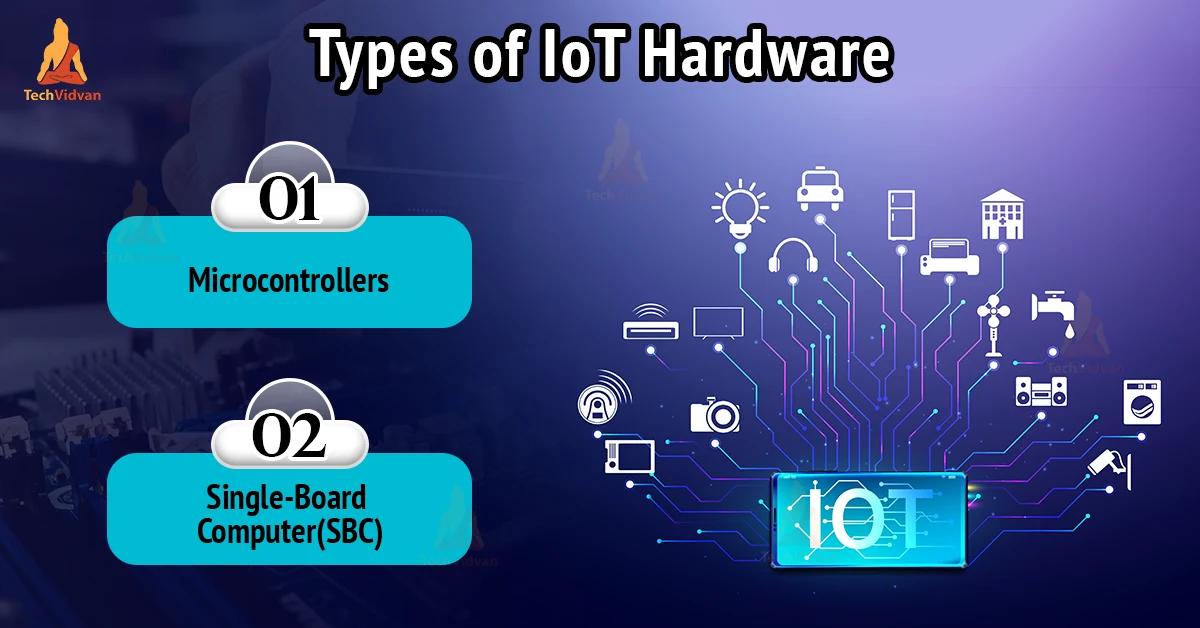Hardware and software devices combine to form an Iot ecosystem. Hardware is a set of devices that wire together to serve some functionality. A bread board is one such example. The bread board usually contains components such as sensors, microcontrollers, microprocessors, resistors, transistors and voltage regulators. In this article, we will look into the hardware components that IoT devices use and we will study further about these components.
Assume that you want to build a drone, a flying device. You want to attach sensors to this drone so that it can take photos of your agricultural crops to keep a track of their growth.
Or maybe you want to build a smart watch. A watch that keeps a track of your entire
schedule, count the number of steps you take daily, measure your heart pulse. This will require you to connect small components, track the battery usage.
You may wonder how we construct these IoT devices? The answer is IoT devices are a combination of hardware and software. The two components integrate together and perform a variety of functions.
Building blocks of IoT Hardware
1. “Things”: Things in IoT are any devices that are capable of connecting to the internet. They can transmit, retrieve and store huge amounts of data that they collect from the surrounding. They include home appliances such as geysers, microwaves, thermostats and refrigerators
2. Data Acquisition module: As the term suggests, this module is responsible for acquiring data from the physical surroundings or environment. These could include changes in the temperature, movement, humidity and pressure.
3. Data processing module: This module includes computers that process the data acquired from the previous module. They analyze the data, store data for future references and other purposes.
4. Communication module: This is the final building block and this module is responsible for communication with third party vendors. This could include device to device, device to server or device to user.
IoT Hardware Providers
Various companies have come up with their own personalized Iot hardware and software and many emerging companies are adapting to these policies. However, the most common Iot hardware providers are listed below:
a. Adafruit is best if you want to get hands-on experience with IoT. The company sells IoT DIY kits with an online guide to help you through the initial setting up. You can interact, manipulate and store your data.
b. Arduino has been synonymous with IoT since the beginning. The company brands microcontrollers, IoT kits and software tools.
c. Lantronix is a software as a service(SaaS). It provides solutions for the internet of things such as networking, engineering , artificial intelligence and smart hardware.
d. Espressif can interconnect with the system to provide wifi and bluetooth. It has high level integration. It uses low power and has a robust design.
IoT Hardware Devices
1. Sensors
A sensor is an IoT device that senses physical changes in the environment and sends the data for manipulation via a network. Clouds store the data for future references. Sensors monitor data and collect information constantly.
2. Microcontrollers
A microcontroller is a small computer that is capable of performing operations. It sits on a semiconductor integrated circuit chip. Microcontollers usually operate on a single function and hence differ from regular computers. They perform a variety of tasks in a relatively simpler manner. We will learn further about microcontrollers in a while.
3. Wearable devices
Wearable devices are a benchmark revolution of the IoT industry. These are Iot devices that humans can wear on their bodies to regulate and perform a variety of tasks. These wearables are capable of tracking glucose levels, monitor heart attack risks, coagulation and asthma monitoring, daily step and calorie consumption tracking.
4. Basic devices
Traditional computers such as desktops, tablets and cellphones are still an integral part of any IoT ecosystem. Desktops offer users with simple access to a lot of information and cell phones allow remote access to Iot devices using APIs.
5. Datasheets
Datasheets give the details about the functionality of any hardware components. It is important to study the datasheet of any hardware before making a purchase to make sure you are buying the right product.
Datasheets offer you detailed information on the parameters of the hardware, its physical size, different voltage and electrical parameters, maximum current usage and the number of input/output pins.
Datasheets are highly useful as they give you all the information you need before buying complicated hardware components.
6. Integrated circuits
Integrated circuits are chips. They are microcontrollers. You can buy empty chips in the market and download any kind of design into the chip. They are made using Silicon and it is packaged into shapes of rectangles. These chips contain complicated logic circuits, gates, registers, switches, I/O terminals and flip flops.
Integrated circuits do a variety of functions, they can perform arithmetic and logical calculations. They act as processors too. They contain binary coded information which is programmed to perform a set of tasks.
Standard chips are available in the market that perform a fixed set of operations. You can also construct chips to perform your desired set of functions and these are known as custom made chips.
Types of IoT hardware
It is easier to develop an IoT application these days due to the ease in the availability of boards, Integrated circuits, prototype kits and platforms. These hardware components are low cost and reliable, they offer flexibility and the choice to design custom sensors with specific applications. At the same time you can also specify the networking area, data management and other functionalities you want your IoT application to have.
The two most common System on a chip(SoS) Integrated Circuits these days are Micro Controllers and Single-board computers. SoCs place microprocessors, storage, networking and data processing on a single unit in the chip and thus they are largely in use in the market to manufacture IoT devices. There is a wide range of hardware components to choose from and based on your requirements you can pick the one that matches your proptype perfectly.
“Make sure to check out the reference link where you can learn further about IoT hardware and their properties.”
a. Microcontrollers
Microcontrollers are a type of SoC that provides data processing and storage units. They contain a processor for processing , ROMs and ROMS for storage.
IoT hardware is tightly constrained. There is a lot to fit in a tiny amount of space unlike a desktop or a laptop. When you start building an IoT system, you must pick a microcontroller that fits your desired purpose. You might have to look at its datasheet to understand the properties and specifications.
Microcontrollers are the centre of the IoT system. They have properties such as Datapath Bandwidth. Datapath Bandwidth specifies the number of bits in the registers. The more bits the more accurate the results are.
Microcontrollers connect to all the components of the system and thus they must have adequate input/output pins. Microcontrollers must have performance depending on what system you are developing. IoT systems are real time applications which require timers. Digital to Analog converters and Low-power modes.
Microcontrollers use a communication protocol to communicate with one another. The most common ones used are UART, I2C, SPI etc. The protocols are helpful when you are building bigger systems that require constant communication with other devices.
We mainly use microcontrollers for low power requirement, simple tasks.
The common and popular microcontrollers available are Arduino Uno, Particle Electron and Espressif Systems ESP8266-01.
b. Single-Board Computer(SBC)
SBCs are single board computers that contain all the processing and computing properties of a computer on a single board. SBCs have memory units to store code and data, input and output units and microprocessors for computing. It also includes an in-built RAM. Cellphones, video game consoles, appliances use SBCs.
They are a preferred choice in Iot industrial applications as they improve the functionality of a regular computer, they are easily available and reduce the cost of transportation. SBCs deliver high performance and are extremely reliable Iot hardware devices.
Based on the kind of project you are making, you choose a SBC that fits into all your needs for that specific project. SBCs are ready made and available in the market at cheap prices as compared to desktops and computers.
The types of SBCs commonly available in the market are Raspberry Pis, Beagleboard and Qualcomm DragonBoard 410c.
Summary
In this article, we learned about what is Iot Hardware, what are datasheets and the different types of IoT hardware such as microcontrollers and SBCs.

